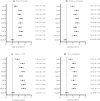Is visceral abdominal fat area a better indicator for hyperglycemic risk? Results from the Pinggu Metabolic Disease Study
- PMID: 31981444
- PMCID: PMC7378436
- DOI: 10.1111/jdi.13217
Is visceral abdominal fat area a better indicator for hyperglycemic risk? Results from the Pinggu Metabolic Disease Study
Abstract
Aims/introduction: The aim of the present study was to analyze the strength of association between fasting plasma glucose (FPG), 2-h postprandial glucose (2h PPG), hemoglobin A1c (HbA1c), disposition index (DI) and nine anthropometrics measures, to explore the best indicator for hyperglycemia.
Materials and methods: Analyses were based on the cross-sectional data of 3,572 adults from the Pinggu Metabolic Disease Study. Anthropometrics were measured, visceral fat area (VFA) and subcutaneous fat area were calculated using an abdominal computed tomography scan. Linear regression was used to analyze the association between FPG, 2h PPG, HbA1c, DI and nine anthropometrics measures (height, weight, waist circumference [WC], body mass index and waist-to-hip ratio [WHR], waist-to-height ratio, VFA, subcutaneous fat area, and visceral-to-subcutaneous ratio). Logistic regression was further carried out to understand the association between per standard increase and risk for hyperglycemia.
Results: Higher VFA and subcutaneous fat area were associated with higher FPG, 2h PPG, HbA1c and DI after adjusting for other covariates. The strongest association observed after adjustment was WC for FPG, with one standard deviation greater WC being associated with 1.70 increased odds; WHR for 2h PPG, with one standard deviation greater WHR being associated with 1.83 increased odds. The strength of the association between VFA and FPG, 2h PPG, HbA1c, and DI was less than WHR and WC, but slightly stronger than body mass index. Stratified analyses showed that VFA performs better as an anthropometrics indicator in predicting hyperglycemic risk in women than men.
Conclusions: WHR and WC remain the best indicators for hyperglycemic risk among ahealthy Chinese population.
Keywords: Body mass index; Diabetes; Visceral fat.
© 2020 The Authors. Journal of Diabetes Investigation published by Asian Association for the Study of Diabetes (AASD) and John Wiley & Sons Australia, Ltd.
Conflict of interest statement
The authors declare no conflict of interest.
Figures


Similar articles
-
Anthropometry did not approach adequate predictive accuracies for detecting elevated fasting plasma glucose or hemoglobin A1c levels among Chinese children aged 7-9 years.J Diabetes Investig. 2021 May;12(5):781-789. doi: 10.1111/jdi.13395. Epub 2020 Sep 29. J Diabetes Investig. 2021. PMID: 32881410 Free PMC article.
-
Association between carotid intima-media thickness and index of central fat distribution in middle-aged and elderly Chinese.Cardiovasc Diabetol. 2014 Oct 30;13:139. doi: 10.1186/s12933-014-0139-2. Cardiovasc Diabetol. 2014. PMID: 25359238 Free PMC article.
-
Sensitivity of various body indices and visceral adiposity index in predicting metabolic syndrome among Chinese patients with adult growth hormone deficiency.J Endocrinol Invest. 2017 Jun;40(6):653-661. doi: 10.1007/s40618-017-0621-2. Epub 2017 Feb 23. J Endocrinol Invest. 2017. PMID: 28233232 Free PMC article.
-
Postprandial peaks as a risk factor for cardiovascular disease: epidemiological perspectives.Int J Clin Pract Suppl. 2002 Jul;(129):5-11. Int J Clin Pract Suppl. 2002. PMID: 12166607 Review.
-
Visceral adiposity and inflammatory bowel disease.Int J Colorectal Dis. 2021 Nov;36(11):2305-2319. doi: 10.1007/s00384-021-03968-w. Epub 2021 Jun 9. Int J Colorectal Dis. 2021. PMID: 34104989 Review.
Cited by
-
Should insulin resistance (HOMA-IR), insulin secretion (HOMA-β), and visceral fat area be considered for improving the performance of diabetes risk prediction models.BMJ Open Diabetes Res Care. 2024 Jan 8;12(1):e003680. doi: 10.1136/bmjdrc-2023-003680. BMJ Open Diabetes Res Care. 2024. PMID: 38191206 Free PMC article.
-
Phenolic Acids from Fruit By-Products as Therapeutic Agents for Metabolic Syndrome: A Review.Int J Mol Sci. 2025 Apr 18;26(8):3834. doi: 10.3390/ijms26083834. Int J Mol Sci. 2025. PMID: 40332518 Free PMC article. Review.
-
The Demographic Specific Abdominal Fat Composition and Distribution Trends in US Adults from 2011 to 2018.Int J Environ Res Public Health. 2022 Sep 24;19(19):12103. doi: 10.3390/ijerph191912103. Int J Environ Res Public Health. 2022. PMID: 36231408 Free PMC article.
-
Role of secreted frizzled-related protein 4 in prediabetes and type 2 diabetes: a cross sectional study.BMC Endocr Disord. 2024 Jun 4;24(1):78. doi: 10.1186/s12902-024-01613-5. BMC Endocr Disord. 2024. PMID: 38834984 Free PMC article.
-
Sex differences in the association between fatty liver and type 2 diabetes incidence in non-obese Japanese: A retrospective cohort study.J Diabetes Investig. 2021 Aug;12(8):1480-1489. doi: 10.1111/jdi.13496. Epub 2021 Feb 3. J Diabetes Investig. 2021. PMID: 33411970 Free PMC article.
References
-
- Després J‐P, Lemieux I. Abdominal obesity and metabolic syndrome. Nature 2006; 444: 881–887. - PubMed
-
- Hajian‐Tilaki K, Heidari B. Is waist circumference a better predictor of diabetes than body mass index or waist‐to‐height ratio in Iranian adults? Int J Prev Med 2015;6:5 Available from: https://www.ncbi.nlm.nih.gov/pmc/articles/PMC4362276/. - PMC - PubMed
-
- Frank LK, Heraclides A, Danquah I, et al Measures of general and central obesity and risk of type 2 diabetes in a Ghanaian population. Trop Med Int Health 2013; 18: 141–151. - PubMed
MeSH terms
Substances
Grants and funding
- 2016YFC1304901/Major Chronic Non-communicable Disease Prevention and Control Research, National Key R&D Program of China
- 2016YFC1305600/Major Chronic Non-communicable Disease Prevention and Control Research, National Key R&D Program of China
- 2016YFC1305603/Major Chronic Non-communicable Disease Prevention and Control Research, National Key R&D Program of China
LinkOut - more resources
Full Text Sources
Medical

